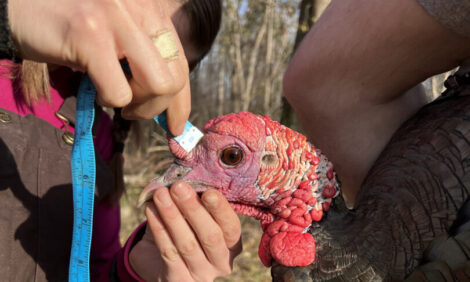



Dominican Republic - Poultry and Poultry Products Report - 2008
The Dominican Republic is basically self-sufficient in poultry production according to the USDA Foreign Agricultural Service (FAS)Dominican Republic Poultry and Poultry Products Report. However, according to the trade, imports are expected during the holiday season due to a production shortfall in 2008. According to US trade data, Jan-Sept exports of poultry meat equalled about 9,200 tonnes. An additional 1,500-3,000 tonnes will be required until the end of the year.Executive Summary
Official estimates for poultry production in calendar year 2008 are anticipated to be 266,000 metric tons (MT) ready-to-cook (RTC) – more than a ten per cent less than in 2007. Table egg production in the same year was three to four per cent lower than the previous two years due to cold weather and high feed prices. Total egg production was estimated at 1.58 billion table eggs per year for 2006 and 2007.
As a result of a poultry production shortfall in 2008, consumption is anticipated to require some imports to cover the deficit (1,500-3,000 MT RTC). Egg consumption is expected to remain at an estimate of 1.56 billion units for 2008, slightly below 2007 levels.
Production
Official estimates for poultry production in calendar year 2008 are anticipated to be 266,000 MT RTC, more than a ten per cent decrease from 2007. Growth in production is driven by the strong demand and poultry’s relatively low price compared to pork and beef; the latter’s prices are high and supplies are tighter due to a smaller domestic cattle and swine populations. Most of the players in the organized livestock reduced output as a result of an oversupply situation earlier in the year and high feed prices experienced in 2008. Egg production was stable in 2006 and 2007 at about 1.58 billion table eggs per year and dropped 3.5 per cent to an estimated 1.52 billion table eggs/year.
The Dominican poultry industry is the most important livestock industry in the country. It is well developed, often vertically integrated and soundly managed. At the same time, it is protected through a system of import permits and relatively high tariff protection (20-99 per cent). Prices are also controlled to some extent by government pressure and a mixture of production subsidies.
Total production for 2006, an all time high, was estimated at 182 million broilers per year equivalent to approximately 289,000 MT RTC of poultry meat. Again in 2007, with an even higher production level of 296,300 MT RTC an oversupply situation was created by the industry and overall production declined. About 35-40 per cent is ready-to-cook (RTC) and the rest is marketed live at the farm level, as well as in the cities.
In 2006 and 2007, table egg production was high and stable, were approximately 50,000 grandmothers in production and 4.8 million layers. Total egg production was estimated at 1.581 billion table eggs per year, for both years. A drop in production has been anticipated due to the feed prices in 2008. Practically all the feed is used in the country is imported from the United States for its quality, proximity and price. In 2007, corn imports were estimated to exceed 1.1 MT and soybean meal imports almost reached 450,000 MT for a total value exceeding US$300 million. Imports for 2008 are slightly lower.
The Dominican Republic produces and consumes only small amounts of duck and turkey. Therefore, the majority of the poultry referred to in this report is chicken.
Feed Availability
The Dominican poultry producers work very closely with the animal feed processors through vertical integration within the industry. The trend is toward greater concentration of farms and processors. All animal feed is domestically produced from a combination of imported and domestic inputs, but mostly yellow corn, yellow grease and soybean meal are of US origin. Small amounts of locally produced yellow corn are also used by the animal feed processing industry.
The partnership between the poultry and animal feed industries also applies to the fertilized egg incubators and is significantly important due to the fact that access to imported inputs is subject to an import licensing scheme administered by the Ministry of Agriculture. Issuance of import licences for yellow corn, yellow grease and soybean meal are readily accessible.
Cost and Quality
The poultry sector will continue to look for quality improvement and cost reduction. The trend appears to be to continue to upgrade the poultry sector. The Dominican Republic delegation was one of the largest from the Western Hemisphere to attend the US International Poultry Exposition & Show.
Feed represents about 80 per cent of total production costs, which continue to climb as the price of imported inputs rise. In addition, labor costs (minimum wage and increasing labor benefits) transportation, marketing and security services are also increasing.
Price Controls
For many years where poultry is a basic food item for the Dominican population, retail prices for poultry as whole birds have been under the government’s control policy. That is, whole poultry are sold at a fixed price established by the Government with industry input. However, to date, the Government agrees to “review” current prices and allow some flexibility, when not in agreement, through direct subsidy to the processors.
Controlled prices for poultry have been a challenge. Unlikely whole birds, poultry products like RTC whole chicken, breast and leg quarters, as well as its boneless and skinless versions, have not been included in the controlled price listings. A current poultry prices are presented below for reference:
| Table 1. Poultry Retail Prices | |||||||
| Live bird, farm level | Whole frozen chicken | Breast, bone in | Breast, boneless | Leg quarters | Chicken wings | Table eggs (unit) | |
|---|---|---|---|---|---|---|---|
| Nov 2007 | N/A | N/A | N/A | N/A | N/A | N/A | 2.40 |
| Nov 2008 | 26.00 | 38.00 | 48.00 | 72.00 | 50.00 | 48.00 | 3.30 |
| Source: Industry November 2008 Exchange rate: 1 USD=RD$34.50 |
|||||||
Consumption
As a result of a production shortfall in 2008, consumption is anticipated to require some imports to cover the deficit. As highlighted in the press and substantiated by the industry, 1,500-3,000 MT RTC of poultry products imports will be needed to cover the holiday season before production levels adjust to the requirements.
Poultry is the meat of choice of Dominican consumers. It remains the most available and less expensive source of animal protein as compared to beef and pork. According to derived figures, between 2007 and 2008 annual per-capita consumption has decreased from 66 pounds to 58 pounds. The poultry sector foresees an increase in consumption as the grain prices return to prior levels and fuel prices stabilize at present levels.
About 60-65 per cent of the poultry produced in the Dominican Republic is purchased fresh by households. The rest goes to the processing sector (RTC, chicken parts [fresh and frozen], hams, sausages etc.). This trend is reverting itself as more power outages limit the use of refrigeration for the Dominican households.
Table egg production estimates for 2008 anticipate a 1.56 billion units for the year, a three per cent decrease over 2007. Egg consumption has increased in recent years much more rapid than poultry production because is the least expensive protein source available for the Dominican consumer. Nonetheless, high international prices of feed ingredients and trade restrictions with Haiti due to the Low Pathogen Avian Influenza Virus (LPAI) incidents have forced producers to decrease production.
| Table 2. Poultry and Egg Consumption | ||
| Dominican Poultry & Egg Consumption (Per capita or number) |
||
|---|---|---|
| Poultry meat (lbs.) | Eggs (units) | |
| 2004 | 54.50 | 124.00 |
| 2005 | 64.00 | 156.00 |
| 2006 | 66.00 | 161.00 |
| 2007 | 66.00 | 158.00 |
| 2008* | 58.00 | 152.00 |
| Source: derived from SEA production reports * Estimates. |
||
Trade
Despite a strong and booming poultry sector capable of meeting domestic demand, some poultry products are imported from the United States (nuggets, mechanically de-boned poultry and turkey). Imports are limited to processed poultry products or whole turkey and its parts. A phytosanitary certificate/import permit system protects local poultry production. The DR-CAFTA agreement includes a tariff rate quota system which allows for a very high level of protection, for leg quarters (20 years) and mechanically deboned poultry meat (ten years). In 2008, this TRQ was 650 MT of chicken leg quarters and another 520 MT of mechanically de-boned chicken meat. In 2009, the TRQs are 700 MT and 560 MT, respectively.
The current tariff for poultry meat is 20-99 per cent plus a 16 per cent Value Added tax (VAT) that is sometimes waivered.
| Dominican Republic | ||||
| Corn and Soybean Meal Imports from the United States | ||||
| Corn | Soybean Meal | |||
|---|---|---|---|---|
| Year | Quantity (MT) | Value ($000) | Quantity (MT) | Value ($000) |
| 2004 | 777,009 | 93,140 | 156,922 | 41,878 |
| 2005 | 968,637 | 95,943 | 264,245 | 61,568 |
| 2006 | 1,210,953 | 145,111 | 423,569 | 90,268 |
| 2007 | 1,144,579 | 188,067 | 448,721 | 121,587 |
| 2008* | 786,771 | 194,436 | 286,913 | 118,897 |
| Source: Department of Commerce, U.S. Census Bureau, Foreign Trade Statistics. | ||||
Stocks
Although there is no official data on stock levels, industry’s rule of thumb tends to have a 30-45 day stock levels, which is equivalent to the birds' life cycle.
Policy
The poultry industry is highly protected. At times, agricultural financing (subsidies) is offered to priority sectors such as the poultry industry. In the midst of the increased commodity prices, the GODR agreed to provide subsidies to poultry and egg producers. It is understood that the allocation to the industry has already been disbursed (US$17.7 million).
Marketing
Almost half of the poultry production and marketing is vertically integrated. Some produce their own poultry for processing and distribution to wholesalers or for further processing and retailing as a finished food product in their food outlets. Some others have poultry available fresh, refrigerated, frozen (whole or in parts) or processed. Refrigerated poultry products include ham-style turkey breast, chicken sausages, chicken bologna, whole-smoked chicken and chicken ham.
The other half of the poultry production is sold live at the farm level or brought into the cities for direct retailers who sacrifice the individual birds and prepare the fresh poultry (RTC) in small corner outlets.
Marketing Difficulties
On 28 December 2007, animal health officials in the Dominican Republic reported an incident of low-pathogenic H5N2 avian influenza (AI) at two sites, one of which is a live-bird market in Santo Domingo and the other is in the village of La Otra Banda in the south-east, according to a report from the World Organization for Animal Health (OIE).
The findings were confirmed at the US Department of Agriculture's National Veterinary Services Laboratories in Ames, Iowa. Three more incidents have been reported in the Dominican Republic in early 2008, which caused trade disruptions temporarily.
Having Newcastle disease, no exports to the nearby islands take place except with Haiti, which shares the island with the Dominican Republic. After several months of discussions with the Haitian authorities, it is believed that informal trade has been restored although officially the border is closed.
Further Reading
| - | You can view the full report by clicking here. |
Other Reports in this Series
To view our complete list of 2008 Poultry and Products Annual Reports from USDA FAS GAIN, please click here.
December 2008







